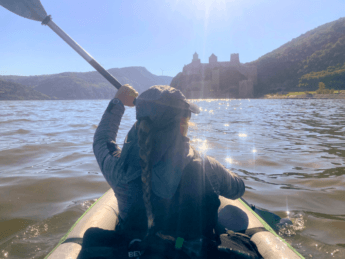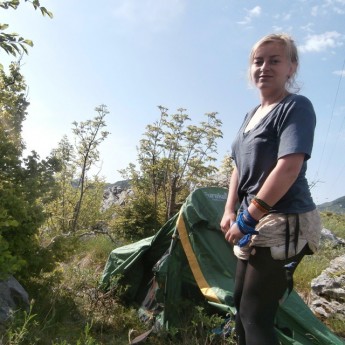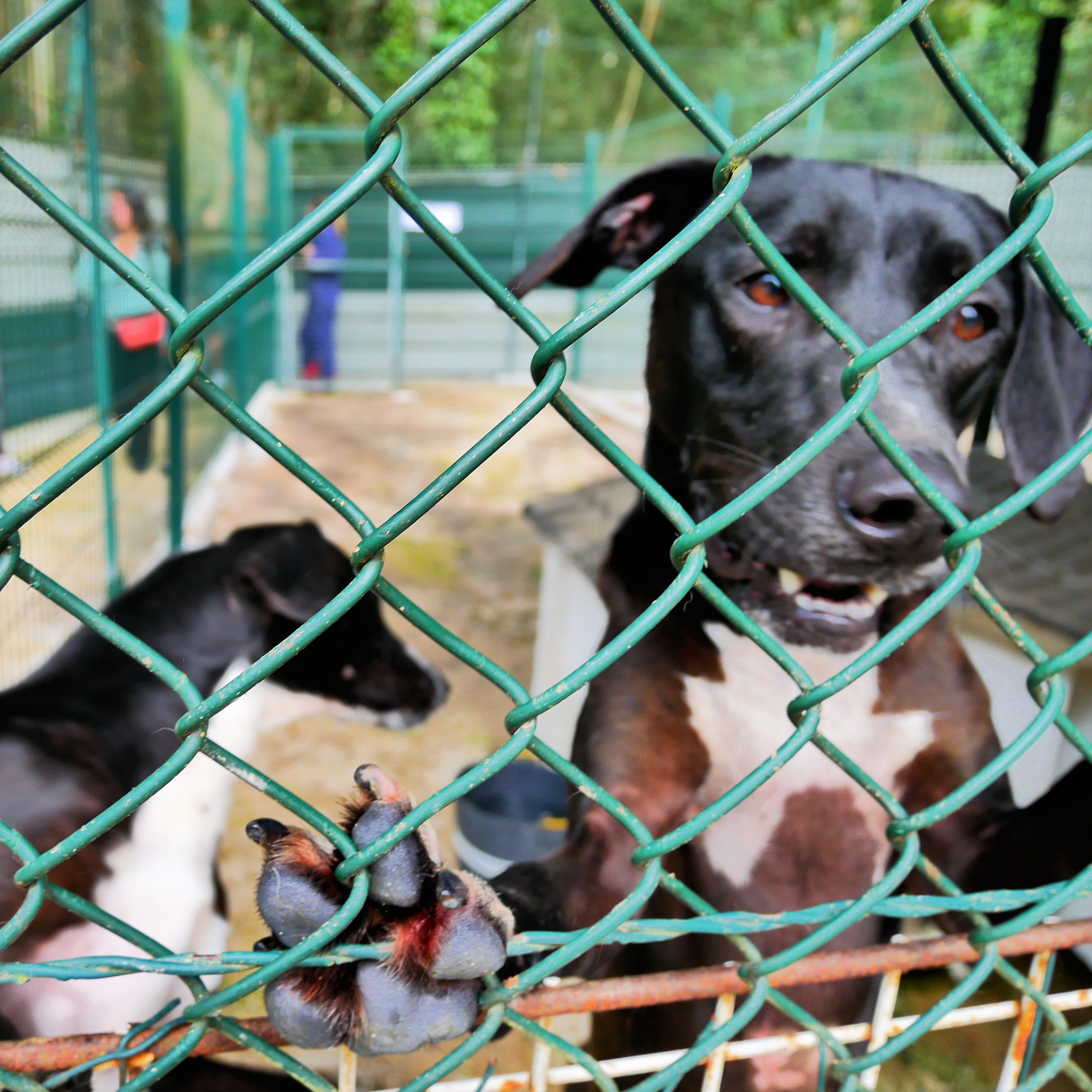
Delayed Gratification
In summer 2018, I wanted to hitchhike to the highest point of mainland Portugal. It’s a mountain named ‘Serra da Estrela’, which can be translated as ‘Star Mountain Range’. A peak called ‘Torre’ is the highest point at 1993m above sea level, which isn’t too shabby – but also won’t cause trouble breathing. My partner Jonas and I were staying in Porto, which is only 200 kilometers from the mountain peak.
Back in October 2015, I was also in Portugal, but more south in Lisbon and Cabo da Roca. Back then I did some research into what the highest point of Portugal is and if it’s hitchable. When I found the Serra da Estrela on my map, I was very happy to see that there was a roundabout on top. This way, I can just hitchhike it up instead of climbing it. I am, in a sense, very lazy.
Alas, back in 2015 my plans changed very spontaneously, and then I left for South America for two years. But in 2018 I was back in Maastricht trying to finish my studies, which means in the summertime I get about 8 weeks of summer holidays. When my partner told me he wanted to go to Porto, I knew I had a great opportunity to finally hitchhike that peak. So I said goodbye and see you later to have a short solo hitchhiking adventure.
Long Time No Hitch!
Events happened on July 13th and 14th, 2018
But there was a problem. After spending one semester back at university, my thumb had become a bit atrophied; I hadn’t hitchhiked in a few months. You see, hitchhiking is not only physically an exercise… but also mentally. It takes some time to build up the courage to trust strangers exactly enough again – and spending time in the confines of a boring university doesn’t stimulate that part of the brain. So when I was route planning my hitch to Serra da Estrela, I became a bit worried.
After years of hitchhiking, I do know that all it takes to get back that courage is to visit the road, wait beside it, observe the traffic and people, and notice how your feelings about it start to change. But I couldn’t get the worries out of my mind. Besides, hitchhiking out of a big city like Porto isn’t usually a cakewalk. I wasn’t very satisfied with the hitchhiking spot suggestions on Hitchwiki.org either.
As a last resort to build up courage and regain control over my ruminating brain, I lowered the bar to hitchhike: I booked a bus ticket to Viseu – a smaller city nearby Serra da Estrela. From there, I could walk to a hitchhiking spot from the bus station and get into the mood for hitchhiking. I already made some of my hitchhiking signs, which also helps it become more real.
Bus Travel – Ugh!
I’m not proud that I took a bus to Viseu. Already when booking the ticket online, I regretted it slightly. Not just because it cost quite a bit of money, but also because the ticket website threw a fit and technology sometimes makes me irate.
For €11.90, I had a very early ticket on Friday 13th of July to Viseu with Rede Expressos. It would depart at 8:30 and I’d arrive 1.5 hours later. My partner walked be to the bus station (rodoviária) in Porto. Putting my backpack in the bottom made me angry. It’s that anger at how things work in the world that fires the light inside me that makes me hitchhike.
I started reading a book I picked up at a book exchange in Ecuador in 2017, which I hadn’t found the time to read yet somehow. It’s Into the Void by Joe Simpson. He’s a mountain climber who got into some deep shit, then crawled out of that and wrote a book. I thought it would be some nice light reading that would make me feel good about hitchhiking mountains instead of climbing them.
When we arrived in Viseu, a man tried to give me some religious event flyer while I was picking up my backpack. In order not to get into a discussion, I reached out for the paper, but then he held up his hand for money and said something about paying for the piece of paper. The apparent misunderstanding upset me a little, and I walked off to repack my backpack. Had I lost my talking to strangers skill?
Mojo Lost?
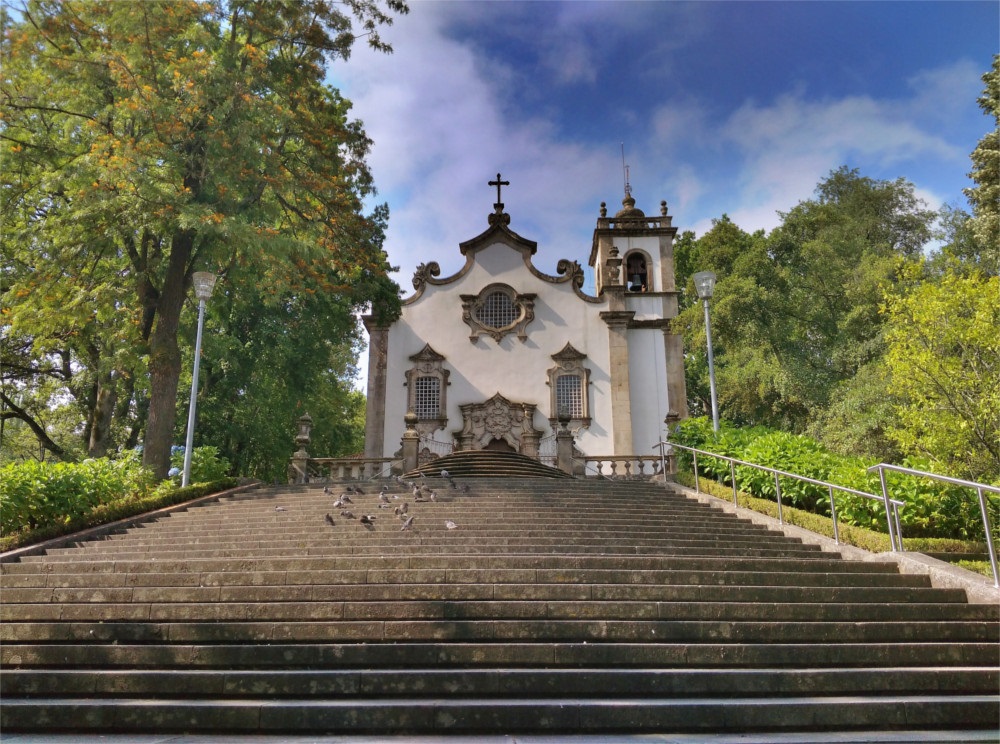
On a sunny Friday morning, the Viseu’s cute little center was quite dead. I walked through, not stopping very often. I was happy to see the first road sign that announced the Serra da Estrela – this validates my plan! But I was quite hungry by now. I knew there was a shopping mall on my way out of town, so I went there and got myself sandwiches and a big bottle of water. This would be enough water and food to camp near the peak – if I wanted to.

My stretch of road I’d try to hitchhike appeared: the Estrada de Nelas. It was an endless stretch of fairly useless roundabouts. After every roundabout, the area seemed to get more rural. I grabbed my sign saying ‘Seia’ and hitch-walked reluctantly onward. After such a long stretch of not hitchhiking, one way to keep the stress levels low is by not putting up your thumb for trucks. Trucks are nearly always driven by men, and men can be very stressful people to be around. So I only showed my sign to about 1 out of 3 cars.
None of the cars showed any sign of considering stopping, which gave me doubts. Was I doing it right? Should I just stand still on one spot? Should I try trucks, too?
The First Ride in a Long Time
A tiny car stops about 100 meters in front of me. I see a hand waving from the driver’s window. That’s my cue to come in, so I sprint towards it. A woman sits inside, and I show her my sign again while saying Olá, bom dia. She smiles at me while saying something about not going that far, but mentioning Nelas, the next town. I agree and get in the car.
Her name is Anita and she’s a truck driver (!) by profession. She speaks Portuguese/Spanish/German with me, and I respond in what I presume is Portuguesified Spanish. We manage just fine to communicate. She tells me she wanted to help me because I’m a woman alone and the men here in the region are no good. That’s also why she doesn’t have a man. I feel extremely comfortable around her and I’m very happy that my first ride in such a long time is with a woman, especially such a funny one with great stories.
Anita drives me to Nelas, which is a little further than she needs to go. We talk, she tells me stories, and I think it’s funny how my brain can just function with understanding all these languages, then formulate something comprehensible enough to say back and have her understand it. So little is necessary for two people to understand each other.
She drops me off at a roundabout inside Nelas, then waves when she drives by the other side of the roundabout on her way home.
Nelas to Seia
At my new hitchhiking spot I’m about to put my backpack down when the next car stops. It’s a shiny car with Swiss plates. There are two people inside, a man and a woman. They’re going to Seia, but my German seems to be not working very well. Teresa and João are from Switzerland and Portugal, and they speak Portuguese to one another. They live in Lucerne and travel back to Portugal every summer.
The ride is nice and comfortable until I notice they are actually two cars traveling together. There is a car in front of us and Teresa is communicating with them on the phone. At a roundabout near the river Seia, the other car takes a wrong turn. Eventually, they decide to drop me off first before chasing down their friends. I thank them for the ride and see them drive off quickly.

I spend a little time walking through Seia before heading back to the road, trying to find a good spot to wait at. The area has become quite mountainous and steep. I try to take a shortcut through a street, but find myself facing off with an angry dog. It’s barking at me, and it wins, so I take another route.
In the center of Seia, I saw a young man and woman get out of a car. A little while later I’m waiting at the steep main road when they drive by. I put up my thumb, and they stop. They’re a Spanish couple named Luis and Serra. They’re from Madrid and visiting this part of Portugal on holidays. We speak Spanish, and they’re wondering why I speak so much of it. I tell them that I spent two years hitchhiking in South America. It’s funny how incredibly natural it feels to me to speak Spanish again, even though I hadn’t done that in six months.

They drop me off a few minutes later in Sabugueiro. They’re taking the adventurous road to Manteigas on the other side of the Serra da Estrela Natural Park we’ve already entered. The waiting times since my first ride have been very short, and I’m feeling optimistic about reaching Torre very soon.
A Longer Wait
At the end of Sabugueiro, I put down my backpack and wait. There are people around and my presence is drawing quite some attention. The road is skinny and turns sharply just a few meters behind me. It’s hard to find a good spot for visibility. On top of that, one of the people moves their car in a way that there’s not really a good hitchhiking spot with a nice stretch for people to stop their car safely.

Across the road, there is a sign saying ‘Há cães’ – there are dogs. The Serra da Estrela region is also known for a specific dog breed: the Estrela Mountain dog. I can hear the puppies barking at a high pitch, and remind myself that there’s a kitten stuck at my Airbnb in Porto. While I can’t really tell whether they’re this specific fluffy dog breed, it’s my best guess. They’re under a metal roof, and it’s quite a warm and sunny day. Poor dogs.
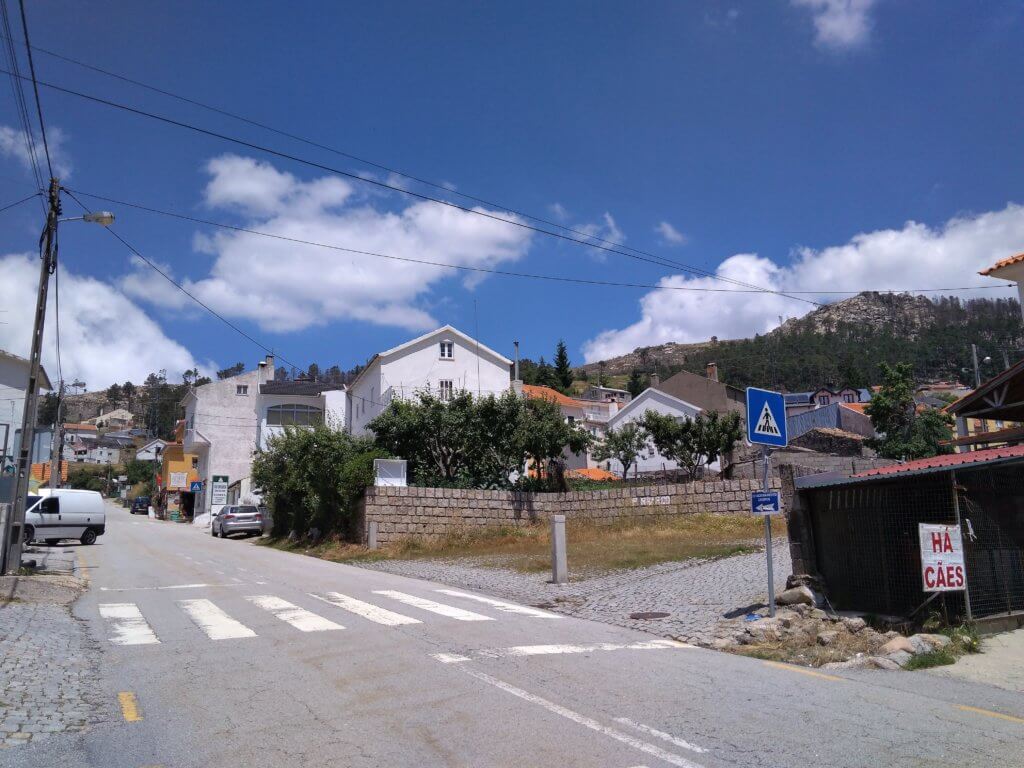
Only a few cars pass by, and sometimes it’s just a pickup truck that has the businesses around my hitchhiking spot as its destination. I put my backpack down and reapply sunscreen. A local man walks past me and says some nasty things. I hope I get a ride soon.
A Tour of the Dams
A shiny car drives into the street, and it stops for me. There is another car behind it, that also stops. A young man with a French accent jumps out of the back seat and opens the trunk for my backpack. I ask if they’re going to Serra da Estrela, and the answer is yes. The young man seems to be genuinely happy to see a hitchhiker out here. His name is Nelson, and he and his family are on holidays in Portugal. They have a summer house in the region and they’re doing a day trip to Serra da Estrela.
Nelson is a 24-year-old student and also hitchhikes sometimes. He did a semester abroad in the Netherlands and liked it a lot. I tell him I’m also a student, but not enjoying it so much. His sister Lisa is 22 years old. The other car contains the family, of Nelsons’ mom’s sister, or something like that. They speak Swedish to each other.
We drive the twirly road up the mountains into a beautiful area full of dams (barragem) and reservoirs. The area is dotted with artificial lakes that catch the water from winter’s precipitation. We make a stop at the biggest one, the Baragem de Lagoa Comprida. It’s an impressive structure, quite brutalist in its appearance. Once looking over the edge onto the lake surface, a powerful wind emerges, nearly blowing my hat off my face.

As a group, we walk over the entire dam. I chat with Lisa, who really likes drawing. She shows me some of the art she made this summer. When we all hike to a beachy place on the side of the lake, she starts drawing the environment. The men are doing the bouncy pebble-throwing on the lake water. Lisa feels interrupted when we head back to the cars before her first draft is finished.
Serra da Estrela: Top of Portugal
We continue onward, making a few more stops at lookouts over tinier lakes. Eventually, we see the exit to Torre, the top of Portugal. We drive up and park next to the shops. It’s surprisingly busy, considering that I’ve carefully watched all the traffic passing from one out of two ways to the top.

Still as a member of the group, we walk around through the shops and the lookouts on all sides. There are sporadic heaps of stubborn snow up here, even though it’s still quite warm and sunny at nearly 2.000m altitude. I help take photos, then we say goodbye. I head into one of the restaurants to celebrate the hitchhiking goal of the day with a Tagus beer and sliced Serra da Estrela cheese (queijo). I’m thinking of buying a blob of cheese at one of the stalls to bring back to Porto, but I eventually choose not to (something I regret now).
I spend another hour on the peak of Serra da Estrela to enjoy the beautifully wack former radar stations, with their broken domes. There is also an actual tower that looks like a proper medieval torre, with crenulated walls and all. In winter, the place becomes a ski resort under the name of telecom provider Vodafone (may your shite company be hit by a meteorite). Right now, the chairlifts wobble in the wind, the snow cannons point to nowhere, and the ski slope looks like an industrial accident rendered the land useless for future generations to come. But it’s nice.

The roundabout on the top encircles a Christian cross on the Actual Highest Point. I take some more selfies when a young couple in activewear walks up to the same cross. They see me struggle so they offer to take a photo for me. I politely decline but offer to them. They’re also good. It’s a nice interaction.
I walk towards the road out, as I’ve decided that staying at or near the top will probably not be very comfortable to sleep at. I’m still not sure what my plan is for the night, and I realize the thought of freecamping actually gives me more anxiety than hitchhiking through the night. And I miss my partner. Let’s see where the next ride takes me.
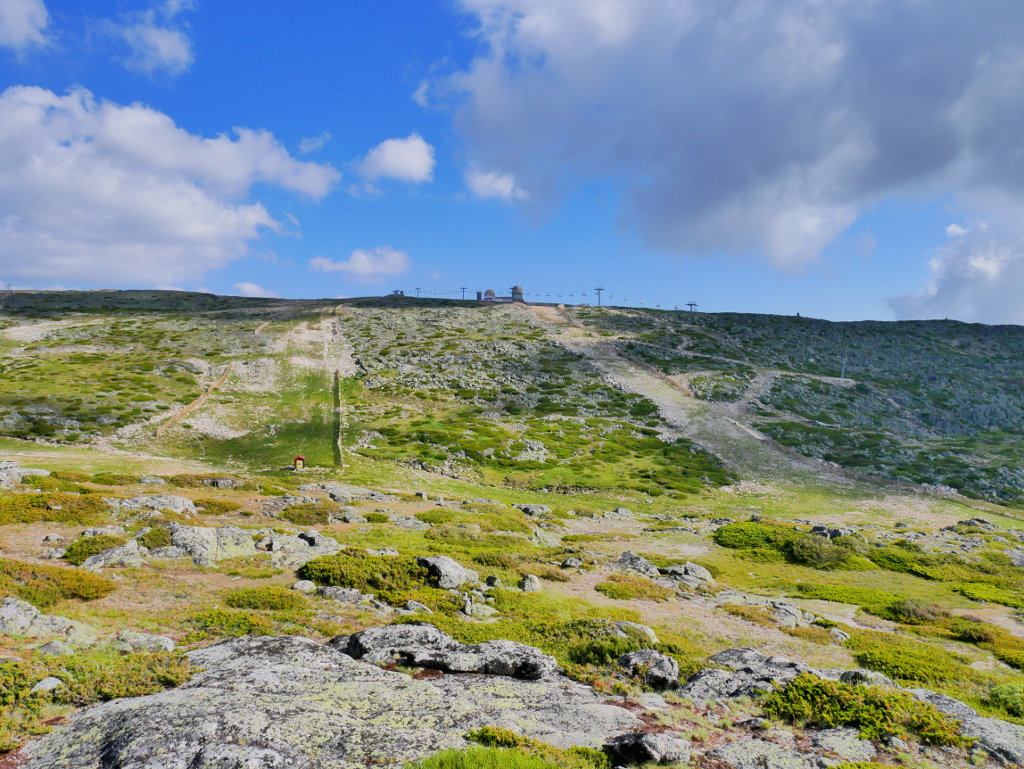
Familiar Faces
I’m walking downhill and try to thumb a few vehicles that pass but don’t stop. Then I see a vehicle with two smiling familiar faces behind the window: the people I’d met at the cross. They knew they’d stop for me, and I knew it too. The woman rolls down the window and asks me where I’m going.
“I don’t really know yet” I respond. “Where are you two going?”
“We’re going to Coimbra,” she says.
“OK, can I join you?” I quickly decide.
“Yeah of course you can!” she responds. So I get into the backseat and put my backpack next to me. We drive off and turn onto the route I came from.
Do you know that rare feeling when you meet new people, and you directly know that you’re going to be friends? I had that feeling with them.

Her name is Lucia, and her partner’s name is Dorian. This is a rental car. They’re both engineers: he in automation, and she in naval engineering. They’re Croatian and from the coastal town of Rijeka, to which I haven’t been yet. I really like both automation and everything boats, so I fire a bunch of questions out of genuine interest.
They ask me if I’ve been traveling for long, and I respond with “Oh no, I only have eight weeks and I’ve been here for one.” Lucia responds with “Eight weeks?! We only get two!” and only then did I notice how much my standards have changed; only eight weeks is indeed very little time to travel when compared to the four years I’ve been traveling uninterruptedly from November 2013 till December 2017. But compared to people with normal working hours and holidays, eight weeks look like an eternity. I tell them that I’m coming down from four consecutive years of hitchhiking, which are being interrupted by a gap year to finish university.
Green Valleys, Blackened Forests, Unfinished Highways
We make many stops along the road. On my suggestion, we take a few smaller roads down the mountain. I help navigate with my offline map through the tiny villages Sazes da Beira and Corgas. We follow the Alva river through Sandomil, São Gião Penalva de Alva, and onto the main road north of this valley, direction Coimbra. Mentally, I’m still looking for a camping spot for the night, but I also don’t really want to say goodbye just yet.

We make a stop on the main road to observe more closely something I’d been observing in the region all day: blackened, leafless trees. I’d learned before from Anita that the region was affected by a large forest fire the year before. It takes quite some time for this to recover. Dorian’s special interest is the lush green on some of the trees. Upon closer examination, it looks as if a parasitic species uses the grilled tree as its host, to replace it from within.

Back in the car, I tell my drivers I decided to ride with them to Coimbra. I start booking a room for the night as we drive onto a stretch of brand new highway (IC 6) that will one day pass south of the Serra da Estrela to Covilhã. The first stretch was finished in 1997, and progress was hampered and troubled by financial problems. While the government talks about restarting construction, some smart people who know how to manage expectations have not given an end date for the project.
Coimbra
We arrive in Coimbra around sunset. I say goodbye to Lucia and Dorian and wish them a pleasant rest of their trip. I wish them good luck with watching the World Cup Finals – Croatia versus France – the day after tomorrow. Tomorrow they’ll head south in direction Lisbon, where they’ll watch the match from.
I check myself into the guesthouse Infante Dom Henrique, munch one of my stacks and stacks of triangular sandwiches, then fall asleep. My body does not regret not camping on a mountainside that night, and neither does my mind. I dreamt of kittens.
I wake up early, shower, and pack up my things. Check out time is at noon, so I spend three hours walking through the city sans backpack. Coimbra is only 1.5 hours away from Porto by train, but a whole different world in terms of tourism. I’d spent the previous week walking through Porto and mumbling “Dutch people” in jest every time I heard my native tongue spoken on the streets. It was inescapable.
This Saturday morning, Coimbra was remarkably quiet. All businesses were open and people were about, but no aggressively-sized YellowBusTours double decker cut you off while waiting >5 minutes to cross the damn street. A busker tuned his guitar while his precious pup lay in his guitar case. In another street, some university students in cloaks with musical instruments – a band called a tuna – are getting ready to play.
Dissatisfied with my vast array of sandwiches, I headed into the café Santa Cruz at the central square expecting it to be a bad budgetary choice (it wasn’t). While sipping a galão and some very sweet croissant, I do my research on where to hitchhike from. Then I head back to the hotel to pick up my stuff and hand over the key.

The Hitch Back to Porto
It’s not a far hike to the road. My first guess of research was that the Galp gas station at the Circular Externa de Coimbra would be good. It wasn’t. Over the next hour, I try three more spots around this road and the giant roundabout 1 kilometer west of it. Things are not looking great, and I feel like it’s not going to happen today.

All the roads on my map lead onto one or two highways, in direction north-south. I keep analyzing the map to see which road leads to Porto, and where I could stand. Every road potentially leads to Porto, so the amount of choices is just too big. The roundabout’s homeless population gives me a few tips, which also don’t work.
It’s only 120 kilometers and 1 hour and fifteen minutes from where I stand, but somehow it seems impossible to get to Portugal’s second-largest city. My legs are getting tired from standing still. The sun stings my skin and I feel like my morning shower was pointless as I slap on the sunscreen. In addition to all that bodily discomfort, I need to pee.
A Smooth Ride Home
On my fourth spot of the day, and my 3rd spot on this forsaken roundabout, I see another hitchhiker appearing. He acknowledges my presence but doesn’t approach me. Another hitchhiker’s presence is good news because I’m standing downstream and it gives drivers the choice between him and me. Within a minute, a car stops. I say “Olá, bom dia. A Porto?” and get in.
My driver’s name is Pedro. He drives from Porto to Coimbra almost every day, as he lives in one and works in the other. He’s relatively young for a car owner, has an unkempt beard, and is comfortable switching to English with me. He studied in Coimbra, like so many. He tells me he can drop me off at the Santo Ovídio metro station in Gaia south of the Douro river, from which it’s easy to get to São Bento station where I need to be.
We talk about travel. Where he’s been, where I’ve been, the like. He’s also traveled quite a lot. His first contact was – much like my experience – through the Erasmus student exchange program. He went to Poland. The cheap RyanAir connections from Porto airport also help him. I tell him I’m going to Poland next, Warsaw specifically. The connections are indeed good and cheap.
While zooming past places I’ve never heard of but seem worth a stopover such as Aveiro, I ask Pedro how Porto has changed over the years, with regards to tourism. He tells me about how the city used to be so much quieter before Porto airport underwent renovations to handle its current capacity. Pedro tells me that a lot of the locals complain about the development, but also says that the city used to be much poorer before it became a popular destination. He says “There are people who want the money from tourism without the tourism. They can’t have that. A lot of people don’t realize that things are good right now because of that.”
Change of Topic
Out of the blue, he asks me “What do you think of Portuguese men?” I’m not sure in which direction this is going, so I say “Friendly..?” Pedro refines his question: “What do you think of Portuguese men look. Are Portuguese men attractive?”
I look at his beard again.
Quickly and diplomatically, I decide to go with: “I’m not an expert on men. I think they look fine, not very different from Dutch or German men. Maybe healthier because you get more sunshine over here. Many men here look like they enjoy hiking and camping.”
Pedro agrees with my assessment. I’m still not sure what exactly this was about. I definitely don’t feel qualified to speak for heterosexual women, or Dutch people, or any demographic really. The interaction remained comfortable throughout the ride. We arrived in Gaia within the hour. I thanked Pedro for the ride and waved goodbye.
São Bento
Alongside Santo Ovído metro station I see the hitchhiking spot I would have chosen had I hitchhiked the whole trip to Serra da Estrela. It looks remarkably doable, and regret taking that bus to Viseu a little.
There are six stops from Santo Ovídio metro station to São Bento. The line crosses the Douro river on one of them majestic bridges. At my stop, I of course pick the wrong metro exit and end up on the wrong side of the road. Above ground in São Bento, the place is swarming with people. I feel accomplished for hitchhiking it back. An older man looks at me, sees the hitchhiking sign in my hand and smiles.
Due to my earlier error, it takes me 10 minutes to walk the 300 meters home. I open the door to an empty apartment. My partner is still at an event in the city. All I hear is the desperate meowing of a kitten that’s stuck somewhere. I decide to try to find the kitten and see if I can help it.
Read next: Rescuing a Kitten from Death in Porto – Part I or Part II.
Enjoyed This Story? Share it on Pinterest!








